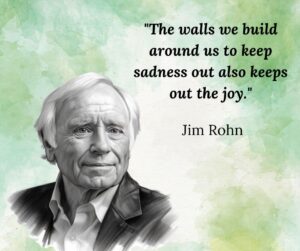Jim Rohn’s powerful message, “The walls we build around us to keep sadness out also keep out the joy,” speaks to a universal truth. It’s a reminder that while self-protection is natural, building walls too high or too thick may cost us more than we realize. Life is a tapestry woven with both sorrow and joy, and in attempting to shield ourselves from the pain, we may unwittingly block out the beauty as well. In this article, we’ll explore why we build these walls, the consequences of doing so, and how we can find the courage to let joy in without fear.
Why Do We Build Walls?
Walls are symbolic of our attempts to shield ourselves from things we perceive as threats. Sometimes, these barriers are born out of painful experiences—moments of rejection, loss, betrayal, or failure. After experiencing emotional wounds, we may unconsciously resolve to never let ourselves feel that vulnerable again.
Fear of Vulnerability: Vulnerability often makes us feel exposed, so we construct walls as a form of self-preservation. Vulnerability, however, is not weakness; it’s the birthplace of joy, love, creativity, and compassion.
Avoiding Discomfort: For many, sadness is uncomfortable and unfamiliar. Our society often emphasizes the pursuit of happiness, and sadness is seen as something to “get over” rather than sit with and understand. As a result, people may push it away, building walls to maintain the illusion of control.
Influence of Past Trauma: Trauma leaves deep imprints, making it hard to trust. A person who has been hurt may create emotional walls to prevent similar pain in the future, often at the expense of meaningful relationships or experiences.
The Consequences of Blocking Out Sadness
While walls may provide temporary protection, they also come with significant costs. By attempting to block out sadness, we limit our emotional range, creating a life that feels safe but also unfulfilling.
Emotional Numbness: When we close ourselves off from one emotion, we inadvertently dull the others. Sadness and joy are both integral parts of the human experience. Cutting ourselves off from sadness can create an emotional numbness that leaves us feeling detached, unable to connect deeply with others or even with our own emotions.
Missed Opportunities for Growth: Sadness and adversity are teachers. They provide us with resilience, empathy, and a deeper understanding of ourselves. By walling off sadness, we also shut ourselves off from the insights and growth that come from facing life's challenges head-on.
Shallow Relationships: True relationships are built on mutual vulnerability and trust. When we refuse to show our true selves—complete with our sadness and flaws—we can end up in relationships that lack depth. Intimacy requires us to open up, to share both our light and our shadows. By building walls, we create distance, making it difficult for others to know and love us fully.
Reduced Capacity for Joy: Just as darkness and light coexist, so do sadness and joy. Blocking one inevitably diminishes the other. By trying to eliminate sadness, we dilute our capacity for happiness, contentment, and fulfillment.
The Role of Sadness in Experiencing Joy
Rohn’s message reminds us that joy cannot exist in a vacuum. It’s in contrast to sadness and hardship that joy becomes vibrant and meaningful. Imagine a life without any sadness—moments of joy would lose their luster, and happiness would become a baseline emotion rather than a cherished experience.
Sadness Enhances Our Appreciation for Joy: When we experience sadness, it can deepen our appreciation for joyful moments. It reminds us of what matters most, making those moments of connection, laughter, and love feel more profound.
Growth and Transformation: Sadness often serves as a catalyst for personal growth. It leads us to self-reflection, helping us to reassess our values and goals. This journey of growth ultimately makes moments of joy more meaningful, as they become celebrations of our resilience and newfound clarity.
Breaking Down the Walls: Embracing Vulnerability
To truly embrace joy, we need to dismantle our walls and allow ourselves to be vulnerable. This doesn’t mean exposing ourselves to unnecessary pain, but rather, it’s about staying open to life’s experiences with courage and acceptance.
Practice Self-Compassion: Start by showing compassion to yourself. Accept that it’s okay to feel sadness, fear, and disappointment. These emotions don’t make you weak; they make you human. Self-compassion helps you release the need to hide from your feelings and fosters a healthy relationship with your emotions.
Allow Yourself to Feel Sadness: Rather than avoiding sadness, give yourself permission to feel it fully. This process of acknowledging and expressing sadness allows it to flow through you, eventually making room for joy. When we resist emotions, they often grow stronger. By facing them, we release them, creating space for more positive feelings.
Seek Connection: Vulnerability is often easier in the company of trusted people. Opening up to friends, family, or even a therapist can be a powerful way to break down walls. When others accept and support us in our sadness, it reminds us that we don’t have to carry our burdens alone. This sense of connection paves the way for a more joyful life.
Practice Gratitude: Gratitude helps us focus on what we have rather than what we lack. It allows us to see moments of joy even in challenging times, shifting our mindset from one of scarcity to one of abundance.
Letting Joy In: Finding Balance Between Protection and Openness
Dismantling walls doesn’t mean leaving ourselves completely exposed. We can set healthy boundaries, learning to differentiate between genuine protection and excessive self-isolation.
Set Healthy Boundaries: Healthy boundaries allow us to protect our peace while still staying open to new experiences and emotions. Boundaries aren’t walls; they’re gates, allowing us to filter what we allow into our lives.
Reframe Challenges as Growth Opportunities: Instead of seeing challenges as things to avoid, try reframing them as opportunities for growth. When we embrace difficulties with a growth mindset, we can allow ourselves to feel sadness while also finding meaning in our struggles.
Focus on Joyful Habits: Cultivate habits that bring you joy. This could be anything from engaging in hobbies you love, spending time with loved ones, or practicing mindfulness. When we prioritize joy in our lives, we create positive emotions that naturally counterbalance any sadness we may feel.
In Conclusion
Jim Rohn’s message reminds us that a life without sadness is also a life without joy. In our attempts to avoid pain, we often lose sight of the joy and fulfillment that come from fully experiencing life. By gently dismantling the walls we’ve built, we open ourselves to the richness of human emotions, creating space for both joy and sadness.
While it’s natural to want to protect ourselves, true strength lies in embracing life’s dualities with courage and grace. By facing sadness, we give ourselves permission to feel joy fully and deeply. Life may be unpredictable, but when we allow ourselves to experience it without walls, we create a life filled with meaning, connection, and true happiness.


















